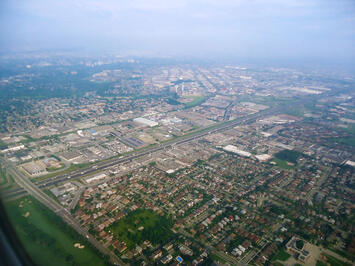
Canada has released early results of the 2021 Census, with a detailed analysis of growth in Census Metropolitan Areas (CMAs). Among the 41 metropolitan areas, 77% of the population growth between the 2016 and 2021 censuses was in the suburbs, with 23% in the urban core (Figure 1). The suburbs have 78.5% of the total CMA population, with 21.5% in the urban core (Figure 2)
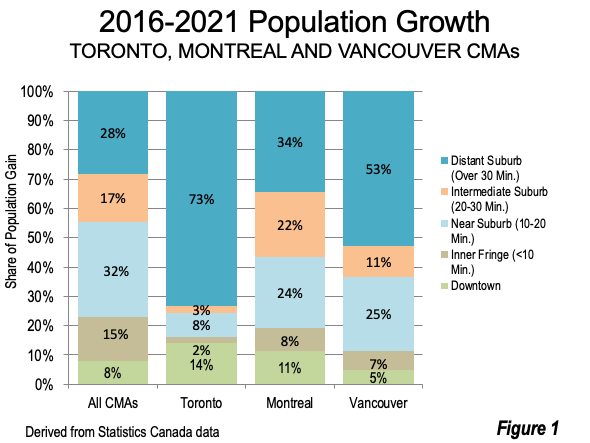
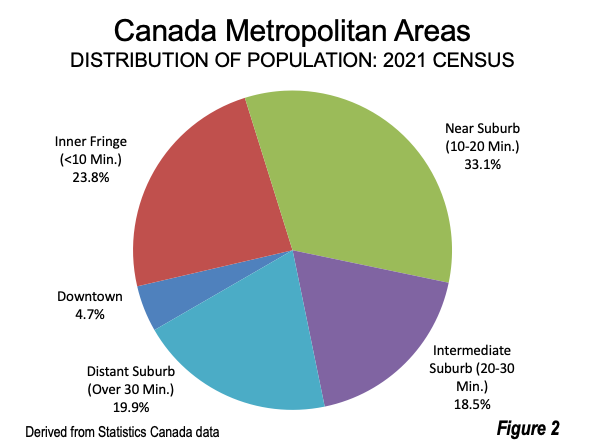
Functional v. Jurisdictional Analysis of Metropolitan Area Components
These population data within CMAs reflect a new classification of CMA components into Downtown, Urban Fringe (which this article calls Inner Fringe, see Note), Near Suburbs (under 20 minutes by car in off peak travel to downtown), Intermediate Suburbs (20-30 minutes by car) and Distant Suburbs (30 minutes and over with off-peak traffic).
This is a considerable improvement on the default core city versus everything else as suburbs (by municipal jurisdiction), long the default option before the major data improvements made possible by advanced information technology. This new Stats Canada classification is similar in concept to a metropolitan area component classification system by David Gordon et al (Queen’s University, Kingston, Ontario), my own City Sector Model and a joint MIT-Queen’s University program developed by Gordon and MIT’s Alan Berger. The Statistics Canada classification uses time radii --- travel time by car to downtown, while the other three approaches use demographic factors, such as population density and work trip travel modes.
MSA’s Over 1,000,000 Population
This article focuses on the six CMAs with more than 1,000,000 residents, as analyzed by Statistics Canada using its new functional classification (above). Statistics Canada has provided a more detailed analysis, including maps (Canada’s large urban centres continue to grow and spread).
Toronto is the largest CMA, with a population of 6,202,000. Toronto is, according to the Stats Canada classification, 88.5% suburban, with 11.5% in the urban core (Downtown and Inner Fringe). The largest population is in the Distant Suburbs (30 minutes and more from Downtown), at 37.5%, with the Intermediate Suburbs housing 29.3% (Figure 3, below). The suburbs dominated population growth, capturing 84% (Figure 1, above). Toronto’s Downtown growth was impressive in percentage terms, but its small size kept the number of new residents to one-sixth the gain of the suburbs.
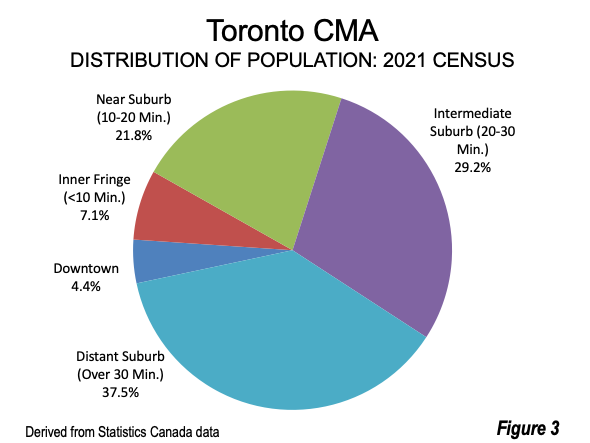
Montreal is the second largest CMA, with a population of 4,292,000. Montreal is 80.7% suburban, with 19.3% of the population in the widely-defined urban core. The largest population is in the Near Suburbs, at 32.5%, followed by the Intermediate Suburbs at 25.3% (Figure 4, below). About 77% of the growth was in the suburbs (Figure 1, above). Montreal’s Downtown had by far the strongest percentage growth, but with numeric growth less than one-seventh that of the suburbs. due to its small population base.
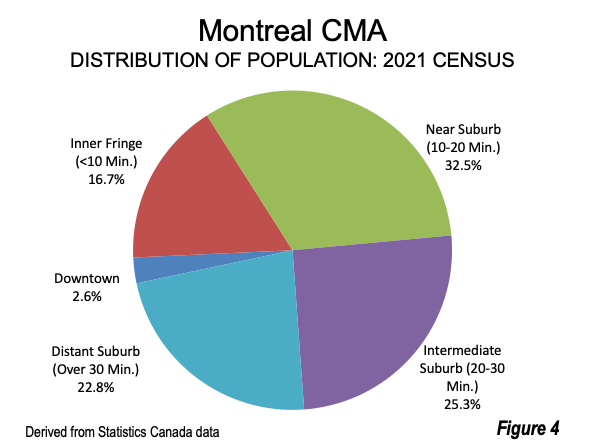
Vancouver is the third largest CMA, with a population of 2,643,000. Vancouver is 82.9% suburban, with 17.1% in the urban core. The largest population is in the Distant Suburbs, at 41.3%, followed by the Intermediate Suburbs, at 25.9% (Figure 5). More than 88% of the population growth was in the suburbs (Figure 1, above)
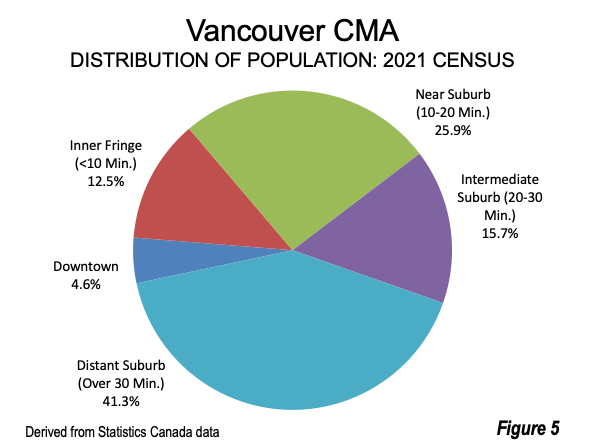
The three CMA’s with between 1,000,000 and 2,000,000 residents have much smaller Distant Suburbs population shares, largely due to the fixed 30 minute limit, which is well beyond most of the urbanization. Many of the residents who would have located in the Distant Suburbs likely settled in the Intermediate Suburbs (or even the Near Suburbs) in these smaller CMAs.
Ottawa-Gatineau emerged as the fourth largest metropolitan area, passing Calgary and Edmonton, with a population of 1,488,000. The suburbs had 68.9% of the population, while the urban core had 31.1% (Figure 6). The largest population was in the Near Suburbs, at 42.3%, followed by the Inner Fringe at 25%.
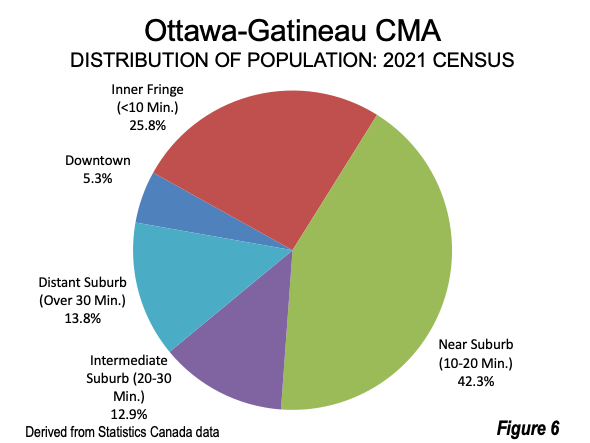
Calgary is fifth largest, with a population of 1,482,000. The suburbs have 80.1% of the population, while the urban core has 19.9%. The largest share of the population is in the Near Suburbs, at 51.4%, followed by 23.9% in the Intermediate Suburbs (Figure 7). The Distant Suburbs had only 3.2% of the population.
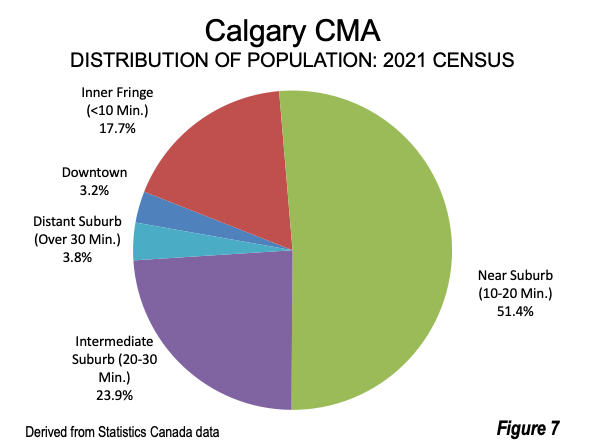
Edmonton is the sixth the largest CMA, with 1,418,000 residents. The suburbs have 78.1% of the population, with 21.9% in the urban core. The largest share of the population is in the Near Suburbs, at 55.1%, followed by the Inner Fringe, at 18.0%. (Figure 8).
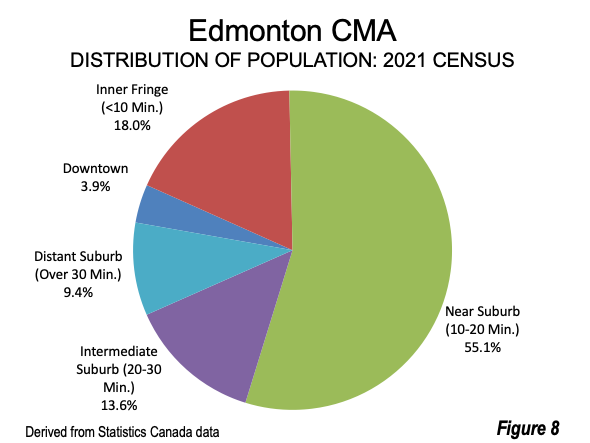
Suburban Nation
Like Australia and the United States, Canada is, as David Gordon put it in 2013, a “suburban nation.” The trend in the five years since the 2016 census only reinforces that judgment. Not only do by far the majority of CMA residents live in suburban areas, but suburbs continue to capture more than three quarters of the population growth.
Note: This article uses the term “Inner Fringe” instead of the Statistics Canada term “Urban Fringe” to avoid potential confusion. “Urban fringe” is often use to denote the edge of an urban area or population centre (the Stats Canada term which is equivalent to the US “urban area.), where the urbanization ends and rural territory begins.
Wendell Cox is principal of Demographia, an international public policy firm located in the St. Louis metropolitan area. He is a founding senior fellow at the Urban Reform Institute, Houston, a Senior Fellow with the Frontier Centre for Public Policy in Winnipeg and a member of the Advisory Board of the Center for Demographics and Policy at Chapman University in Orange, California. He has served as a visiting professor at the Conservatoire National des Arts et Metiers in Paris. His principal interests are economics, poverty alleviation, demographics, urban policy and transport. He is co-author of the annual Demographia International Housing Affordability Survey and author of Demographia World Urban Areas.
Mayor Tom Bradley appointed him to three terms on the Los Angeles County Transportation Commission (1977-1985) and Speaker of the House Newt Gingrich appointed him to the Amtrak Reform Council, to complete the unexpired term of New Jersey Governor Christine Todd Whitman (1999-2002). He is author of War on the Dream: How Anti-Sprawl Policy Threatens the Quality of Life and Toward More Prosperous Cities: A Framing Essay on Urban Areas, Transport, Planning and the Dimensions of Sustainability.
Photo: Toronto – toward the distant suburbs (by author)












